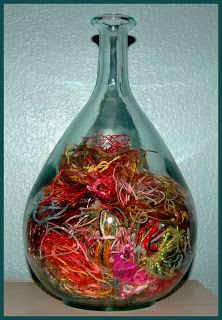One Point Mind
 When you dive into the world of fiber-related crafts, undoubtably, you will eventually come across some rather unique and downright bizarre habits and fascinations. There are too many to go over here, but I will share one of my more recent discoveries: the ORT Jar. You many have even seen pictures of glass containers filled with colorful bits of thread and yarn. These jars of random thread are called ORT jars. There isn’t a consensus regarding the origins of the name. Some say it is derived from the 15th-century German word for “leftover”, referring to the scraps of food that remained after a meal. Other sources say the name is an acronym for “Odd Random Threads”, “Old Ratty Threads”, or “Odd Remnants and Threads”, etc. Another inspiration for the ORT jar might be witch bottles used in 17th-century England and America. Witch bottles were used to protect an individual or a home from evil magic, and curses. They were often filled with a variety of small objects, including hair and thread as part of the ingredients needed to work their magic. Whatever the origin, ORT jars have become a fun part of cross-stitching, and other fiber-arts. Typically the ORT jar is made of clear glass so that the colorful snips, tails, and remnants of threads can be seen. But why keep ORT jars at all? The reasons are as varied as the possible origins of the jars themselves. For some ORT jars are practical, as a way to keep your workspace neat and clean. You may have already experienced the special ability of embroidery floss to travel throughout your home by finding thread stuck to your clothes, socks, pants, carpets, pet’s noses, and fur, just about anywhere! Having a place to put the pieces of threads as you work can save yourself from extra house cleaning. Additionally, those of a more practical nature can use the contents of the ORT jar as stuffing for other projects, like pin cushions, to mend clothing or a finished cross-stitch project, other craft projects, and many other things. Another common reason to keep an ORT jar is more psychological in nature. That is in the encouragement and self-confidence the jars instill. As you see the jars fill, you are reminded of how much work has gone into your project or projects. Some cross-stitch projects can take months or even years to complete, so it can be very encouraging to watch the ORT jar fill up over time. Other crafters use ORT jars as decor to bring color and playfulness to a craft room or other rooms in the home. Clear glass or plastic Christmas ornaments can be filled with the contents of an ORT jar for a unique holiday decoration or gift. Imagine what a conversation piece a lamp with a clear glass fillable base full of colorful snips of thread would be! One thing that the contents of the ORT jar should never be used for is birds’ nests. The threads can be dangerous for birds, as they can get wrapped around their legs or necks cutting off circulation and causing serious injury and even death. Most crafters use a clear glass jar, such as a mason jar, or a food jar, that has been cleaned and dried, with a lid. Glass isn't required, clear plastic containers with a cover can also be used. Any container can be used: a ceramic jar, a metal or wooden box, even a plastic ziplock bag, it doesn’t matter really. However, clear material is preferable if you want to see the various colors of the threads as they fill the container. It's by no means required to keep an ORT jar, but being one of the many unique, and sometimes bizarre fiber-based habits, you may enjoy having one (or several) and joining in on the fun! If you decide to keep an ORT jar, share a picture of it on our Facebook group page!
0 Comments
|
About My WorkMy primary medium is hand embroidery, but I do occasionally work with yarn, pencil, pen, and paint. I also offer commissioned hand-embroidered pet portraits. Archives
July 2023
Categories |
 RSS Feed
RSS Feed